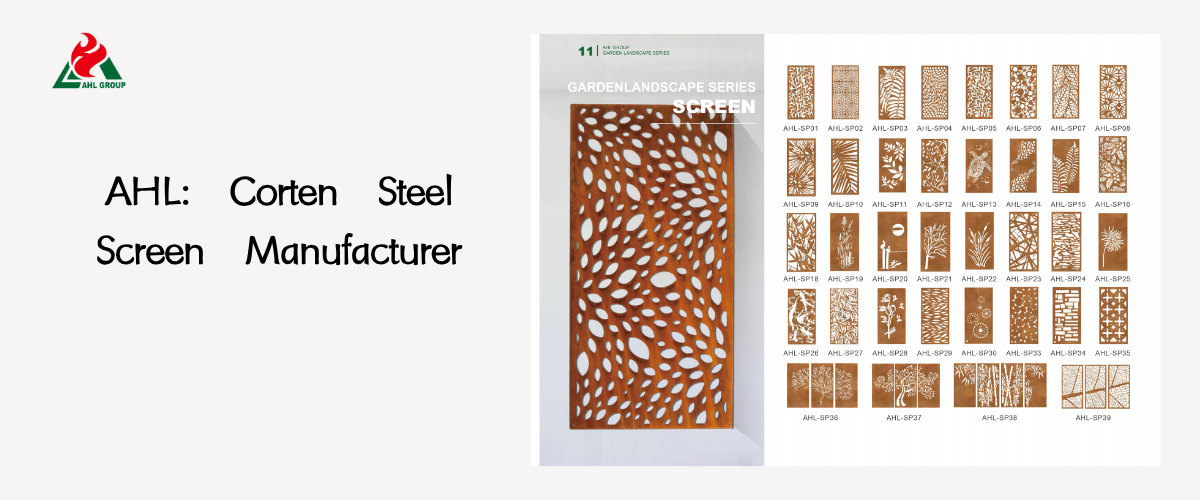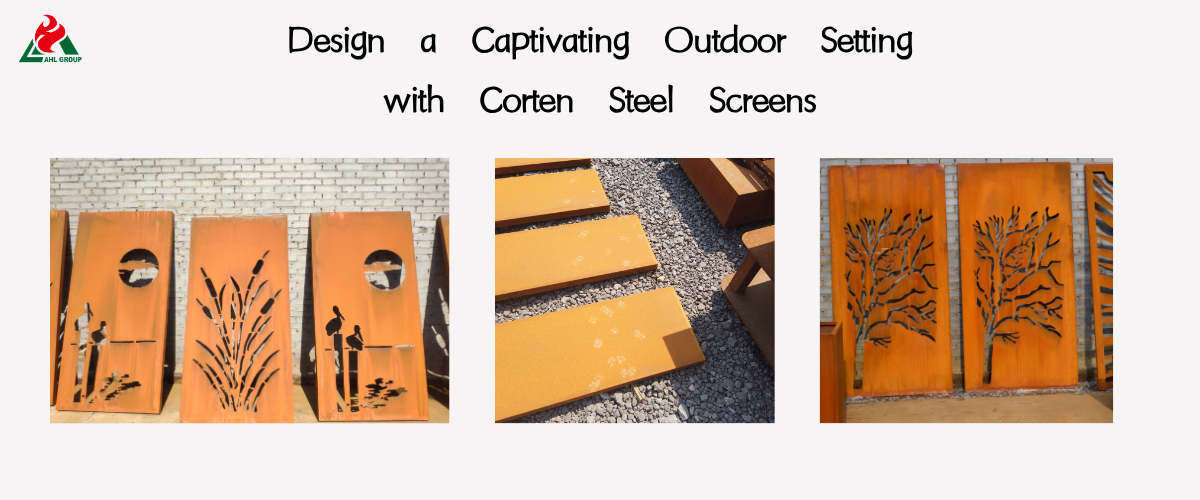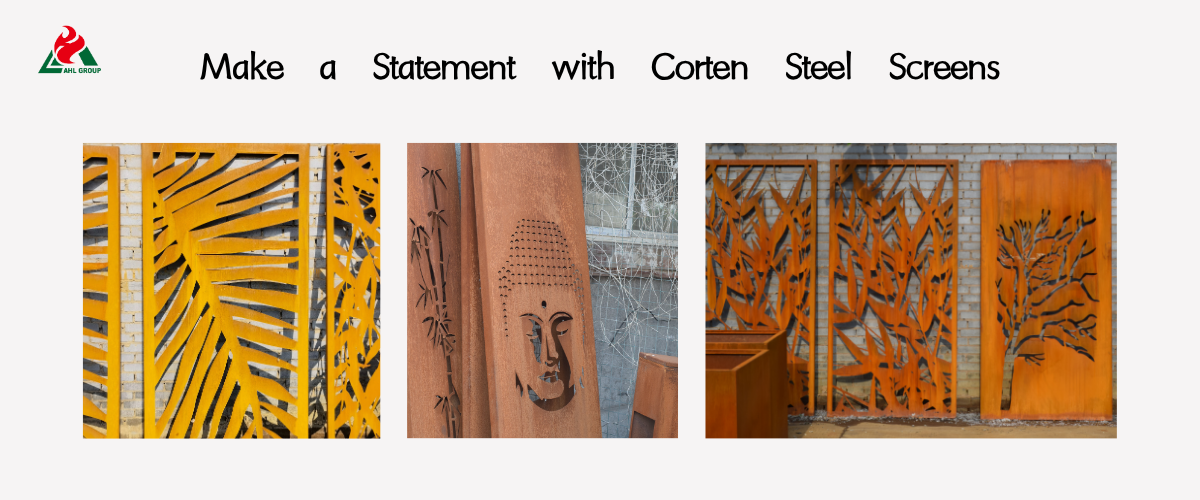As a manufacturer and design specialist within the AHL Group, we focus on producing globally acclaimed premium Corten steel outdoor screens, celebrated for their distinctive rust aesthetics and exceptional industrial resilience. Unlike conventional metals, this weathering steel develops a dense, stable protective patina—known as verdigris—that effectively blocks deeper corrosion. While the inherent durability of weathering steel significantly reduces maintenance needs, mastering these simple care techniques is essential: ensuring the protective verdigris forms evenly safeguards your investment and preserves the screen panel's stunning visual impact for decades to come.


The Durability of Corten Steel Outdoor Screens
Corten steel screens and partitions stand as iconic elements in modern landscape architecture, celebrated for their striking rustic beauty and exceptional durability. Unlike ordinary steel, weathering steel develops a dense, stable protective rust layer (patina) that effectively blocks further corrosion. This inherent corrosion resistance makes AHL Group's Corten screens a low-maintenance, long-term investment. However, “low maintenance” does not equate to “maintenance-free.” Mastering proper screen care ensures their visual appeal and structural integrity endure over time.
Scientific Maintenance for Extended Lifespan
Although the protective rust layer possesses self-sealing properties, external factors—such as residual contaminants, heavy pollution, or prolonged exposure to corrosive substances (e.g., salt spray or concentrated bird droppings)—can compromise this layer, leading to accelerated and uneven corrosion. Simple, routine maintenance prevents such issues, ensuring a uniform, deep rust patina that maximizes the screen's lifespan.
Balancing Natural Aging and Maintenance
The essence of weathering steel maintenance lies in striking a balance: allowing natural patina to occur while intervening to remove harmful contaminants or impurities when necessary. The goal is not to halt rusting, but to ensure the rust layer forms uniformly and sustainably across the entire surface.
7 Practical Maintenance Tips for Corten Screens
For property owners and managers, maintaining Corten steel privacy screens or decorative panels is actually quite straightforward. Here are 7 practical tips from AHL Group to help keep your screens in optimal condition.
Tip 1: Embrace the Natural Process
The core principle of weathering steel maintenance is to embrace its inherent characteristics.
Trust the Natural Weathering Process
The initial phase (6-12 months) is critical for the raw steel to develop its protective patina. During this period, avoid using any sealants, coatings, or abrasive cleaners. AHL Group recommends allowing the metal screens to naturally cycle through wet and dry weather conditions, as these elements help solidify the patina and stabilize the steel.
Tip 2: Conduct Seasonal Inspections
Preventive maintenance is far easier than corrective repairs.
Spring/Fall Maintenance Checklist
Conduct two quick visual inspections annually (ideally in early spring and late fall). Focus on checking bases and edges for persistent buildup of moisture, soil, or organic debris. Remove fallen leaves, mud, or dirt trapped in bases and intricate laser-cut textures.

Tip 3: Use the Correct Cleaning Method
When cleaning weathering steel, handle it gently to avoid scratching the newly formed rust layer.
Gentle Methods for Removing Dirt and Debris
For routine surface cleaning (dusting, light soiling), a soft-bristled brush or low-pressure rinse with clean water is usually sufficient. If necessary, use a mild, pH-neutral soap solution (such as regular dish soap) with a soft cloth, followed by thorough rinsing to remove all soap residue. Never use pressure washers, steel wool, or harsh chemicals, as these can strip the protective rust layer.
Tip 4: Monitor Structural Integrity
The lifespan of a garden screen largely depends on its secure anchoring.
Inspect Posts, Bases, and Connections
Focus on the junctions between the Corten steel outdoor screen and its supporting posts, bases, or walls. Ensure all bolts and hardware (which should be stainless steel or galvanized to prevent accelerated corrosion of the weathering steel) are secure and free of looseness. Pay particular attention to soil erosion around the base, which can compromise vertical stability—especially critical for tall weathering steel privacy screens.
Tip 5: Manage Environmental Factors
Certain environments require more frequent maintenance.
Addressing Salt-laden Air, Pollution, and Hard Water Environments
In coastal areas (salt-laden air) or highly polluted urban environments, outdoor screens require more frequent rinsing (recommended monthly) to prevent accumulation of corrosive pollutants. If screens are continuously exposed to hard water spray, mineral deposits (white stains) may form. Gently wipe and rinse these immediately.
Tip 6: Preserving Design Integrity
Screens with intricate designs demand particular attention to detail.
Maintaining Laser-Cut Patterns and Details
Debris (such as spider webs, dead insects, or fine leaves) can easily become lodged in the precision-cut openings of decorative Corten steel screens. Gently clean these areas using a soft brush or compressed air (leaf blowers work well). Blockages can obstruct light and airflow, potentially leading to damp spots and uneven rust patina formation.
Tip 7: Create a Maintenance Plan
Consistency is key to simplifying long-term upkeep.
Establish a simple, effective daily maintenance routine
Developing a straightforward schedule—such as biannual structural inspections and monthly visual flushes—is far more effective than an annual deep overhaul. Integrate these checks into your existing landscaping maintenance workflow.

Troubleshooting Common Issues
Even with optimal preventive measures, occasional cosmetic or minor structural issues may arise. This section provides quick and safe solutions for problems specific to weathering steel, restoring the screen panel's uniform appearance and ensuring its long-term stability.
Addressing White Stains or Efflorescence
Such stains typically result from hard water mineral deposits, concrete seepage, or high salt concentrations. Gently scrub with a soft nylon brush and clean water. Never use acidic cleaners.
Dealing with Bird Droppings and Tree Sap
Bird droppings are highly acidic and can corrode the rust layer if left for extended periods. Rinse immediately with mild soapy water and gently pat dry. Tree sap should be removed as soon as possible before it hardens.
Accidental Damage and Scratch Treatment
Minor scratches on weathering steel surfaces often exhibit self-healing properties. Fresh steel exposed to scratches will rapidly form a protective rust layer through natural weathering, causing the scratches to gradually fade over time.
Professional vs. DIY Maintenance
Although weathering steel is designed for basic self-maintenance, owners must still understand which tasks are simple and safe for DIY and when to hire professionals to address structural issues and ensure long-term safety.
Safe DIY Tasks
All seven recommendations above are suitable for DIY, including simple rinsing, soft-bristle brushing, and visual inspections.
When Professional Assistance Is Required
If you observe severe structural instability, extensive deep pitting corrosion, or significant installation defects (such as noticeably leaning columns), consult a professional structural engineer or contact AHL Group's technical support team for expert advice.

Conclusion: Maximizing Your Investment Value
Choosing AHL Group's Corten steel screens means selecting enduring aesthetic appeal and structural durability. By following these simple maintenance practices, you can ensure the protective rust patina remains intact, allowing the screens to enhance the quality of your outdoor space for years to come.


